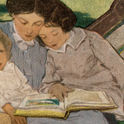On 11th October I appeared on a panel at the National Gallery to discuss questions of art and morality in relation to Paul Gauguin’s life and work. The gallery’s major new exhibition of Gauguin’s portraits rightly raises ethical questions with a now familiar ring. What should we say about Gauguin’s art in light of his despicable personal behaviour? What responsibilities do galleries have when they display the creations of artists who behaved in ways that are now criminal? Should we hold artists to the same moral standards as the rest of us?
Artists often take risks, including moral risks, in pursuit of their art. The novelist James Joyce asked his wife—the wonderfully named Nora Barnacle—if she would go with another man so that he could experience what infidelity felt like. Joyce wanted Barnacle to be unfaithful so that he could better imagine the life of Leopold Bloom, the main character of his work-in-progress Ulysses. This was a strange request, and undoubtedly fraught with dangers, but not obviously morally wrong. Gauguin’s decision to leave for Tahiti in pursuit of artistic greatness is another story.
Gauguin thought that painting in Polynesia would lead him to a new kind of art. He was right, but the life he felt he had to live to achieve this art is deeply morally troubling. He thought of himself as a kind of “noble savage” whose wild nature was essential to his creativity. He slept with—and no doubt gave syphilis to—girls on the island of Tahiti as young as 13. What’s more, as art critic Carolyn Stewart has highlighted, his own writings express the attitude that Tahitian girls ought to be raped and beaten.
One of the defining features of morality, argued philosopher Immanuel Kant, is that one does not make special exceptions for oneself. Creative people, however, at least until very recently, have been encouraged to think of themselves as extraordinary individuals to whom normal moral rules don’t apply. “I’m special, so special,” as Chrissie Hynde memorably sang in Brass in Pocket, a song which might be considered an artists’ anthem.
British philosopher Bernard Williams argued that artists such as Gauguin were morally lucky in that their aesthetic achievements redeemed choices that for the rest of us would have no justification at all. There’s no doubt that artists have historically been given cultural permission to live in a way that would not normally be considered morally acceptable. You could say that they have been given a moral pass. People look away from the terrible behaviour and focus on the art. But if artistic licence once came with a moral pass, then we have rightly had a cultural rethink about the whole idea of artistic licence. Feminist criticism, in particular, has challenged mainstream complacency about the scale and seriousness of sexual exploitation and abuse. The hashtag couldn’t be clearer: #Timesup.
Time’s up means not just change going forward, but a reckoning with canonical artists of the past such as Gauguin. “What,” as writer Claire Dederer memorably asked, “should we do with the art of monstrous men?” This question is made especially pressing by the fact that so many major artists have behaved so appallingly. Even to consider Dederer’s question, however, tends to raise blood pressure levels. “Shall we close the galleries?” people respond. “Should we just cancel the history of art?” The now common conservative thought is that to make any moral demands on art and artists is to step on a slippery slope that leads to moral purity tests, witch trials (or perhaps wizard trials), and abolition of most of the major art from the “pre-woke” era. But to quote a well-known conservative writer, GK Chesterton, “art, like morality, consists in drawing a line somewhere.” I want to indicate briefly some moral lines in this debate without suggesting that we need to cross out the past.
First, a conservative point. When galleries display art they are—or should be—endorsing the artist as an artist, not necessarily as a human being. To display the art might encourage people to admire the person as a whole but here we need to distinguish between intentions and foreseeable consequences. You might intend to smoke; a foreseeable consequence is cancer; it doesn’t follow that you intend to get cancer. To display art one need not intend a moral thumbs up to the person behind the art even if you can foresee that some will draw this conclusion. This is an important point and often overlooked.
Nonetheless, if galleries adopt a high line on aesthetic criteria, they still have a moral responsibility to think about the foreseeable consequences of their decisions. Are they, for instance, encouraging us to move from love of art to love of artist as a person? Galleries, after all, have gift shops that nudge us in this direction when they sell us everything from purses to place mats with the artist’s face on.
The conservative point about aesthetic criteria has further serious limits. What about, in particular, when the wrongdoing is in the content of the art? Gauguin made the young girls part of some of his most famous and acclaimed paintings. There’s little scope here to separate the art from the immoral artist. Though the behaviour is equally appalling in both instances, there is a difference between the art of a sexual abuser who painted landscapes and that of an abuser who made his victims his subjects. Moreover, some wrongs are so grave that they cannot be ignored.
So one can see why the National Gallery rightly faces questions about its responsibilities when it decides to display Gauguin’s work. That’s why it was a such a good thing that it hosted an event that gave the public a chance to engage with the concerns. The panel discussion I was part of last week—along with Shahidha Bari, Sacha Golob and Janet Marstine—deliberately adopted a Question Time format so as to allow for lots of questions and comments from the audience. There was a full house, great interest in the issues, and many different perspectives.
Artists are no longer morally lucky in the sense that their moral wrongs are pushed to one side. Fame is no longer a shield from moral scrutiny: it’s a magnet for moral attention. The failings of famous artists are now examined and publicised to a degree far beyond the consideration paid to those who commit the same wrongs in ordinary life. The script, in this sense, has been flipped.
We want artists to take risks and for no one to be harmed. We want, in other words, the impossible. But, at the very least, we hope that if artists take moral risks they will belong in some grey area like Joyce’s request to his wife. We don’t mind if artists have been naughty. I will fully understand if it turns out that in real life Fleabag star Phoebe Waller-Bridge seduced a priest. What we don’t want is for our artistic heroes to be evil.
Paul Gauguin, the National Gallery and the philosophical conundrum of exhibiting immoral artists
What responsibilities do galleries have when they display work by monstrous creators?
October 15, 2019

Gauguin in 1891.











